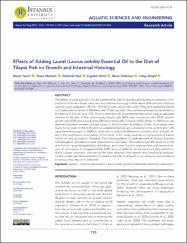| dc.contributor.author | Yazıcı, Metin | |
| dc.contributor.author | Mazlum, Yavuz | |
| dc.contributor.author | Naz, Mehmet | |
| dc.contributor.author | Ürkü, Çiğdem | |
| dc.contributor.author | Türkmen, Musa | |
| dc.contributor.author | Akaylı, Tülay | |
| dc.date.accessioned | 2022-12-05T05:40:27Z | |
| dc.date.available | 2022-12-05T05:40:27Z | |
| dc.date.issued | 2022 | en_US |
| dc.identifier.citation | Yazici, M., Mazlum, Y., Naz, M., Urku, C., Turkmen, M., & Akayli, T. (2022). Effects of adding laurel (Laurus nobilis) essential oil
to the diet of tilapia fish on growth and intestinal histology. Aquatic Sciences and Engineering, 37(4), 195-204. https://doi.org/10.26650/ASE20221101489 | en_US |
| dc.identifier.uri | https://doi.org/10.26650/ASE20221101489 | |
| dc.identifier.uri | https://hdl.handle.net/20.500.12508/2379 | |
| dc.description.abstract | The effects of adding laurel oil to the experimental diet on growth performance, biochemical compositions of fish and feeds, sand liver and intestine histology in Nile tilapia (Oreochromis niloticus) juveniles were evaluated. 180 fish (12±0.02 g) were used in the study. They were randomly placed in 12 tanks with a volume of 500 liters, with 15 fish per tank. The commercial laurel oil was added to the diets at 0, 0.3, 0.6, and 1.2%. The fish were fed with experimental diets twice a day as apparent satiation for 60 days. In the current study, weight gain (WG), feed conversion ratio (FCR), specific growth rate (SGR) and survival rates (SR) were statistically similar (p>0.05). While no difference was observed between protein and ash values in the biochemical analysis of fish, lipid values were found to be lower in the 0.3% and 0.6 supplemented groups compared to the control and 1.2% supplemented groups. In addition, there was no statistical difference in protein, lipid, and ash values in the biochemical composition of the feeds. In the study, essential oil components of Laurus nobilis oil such as Linalool, Elemene, Trans-Caryophyllene, Cis-α-Bisabolene, Α-Terpinyl Acetate, Methyleugenol, β-Eudesmol were determined in low levels. The addition of 0.3% laurel oil to the diet did not cause histopathological findings, and it was found to improve liver and intestinal tissues. In conclusion, it is suggested that 0.3% laurel oil addition can be used as a feed additive in tilapia culture, especially considering the data obtained from growth and histological analyzes. Further studies are deserved need to examine the effects of laurel oil on immunity and resistance to various stress factors in other fish. | en_US |
| dc.language.iso | eng | en_US |
| dc.publisher | Istanbul University Faculty of Aquatic Sciences | en_US |
| dc.relation.isversionof | 10.26650/ASE20221101489 | en_US |
| dc.rights | info:eu-repo/semantics/openAccess | en_US |
| dc.subject | Biochemical composition | en_US |
| dc.subject | Growth parameter | en_US |
| dc.subject | Laurel oil | en_US |
| dc.subject | Laurus nobilis | en_US |
| dc.subject | Oreochromis niloticus | en_US |
| dc.title | Effects of Adding Laurel (Laurus nobilis) Essential Oil to the Diet of Tilapia Fish on Growth and Intestinal Histology | en_US |
| dc.type | article | en_US |
| dc.relation.journal | Aquatic Sciences and Engineering | en_US |
| dc.contributor.department | Deniz Bilimleri ve Teknolojisi Fakültesi -- Su Ürünleri Yetiştiriciliği Bölümü | en_US |
| dc.identifier.volume | 37 | en_US |
| dc.identifier.issue | 4 | en_US |
| dc.identifier.startpage | 195 | en_US |
| dc.identifier.endpage | 204 | en_US |
| dc.relation.publicationcategory | Makale - Uluslararası Hakemli Dergi - Kurum Öğretim Elemanı | en_US |
| dc.contributor.isteauthor | Yazıcı, Metin | |
| dc.contributor.isteauthor | Mazlum, Yavuz | |
| dc.contributor.isteauthor | Naz, Mehmet | |
| dc.relation.index | Scopus - TR-Dizin | en_US |
















